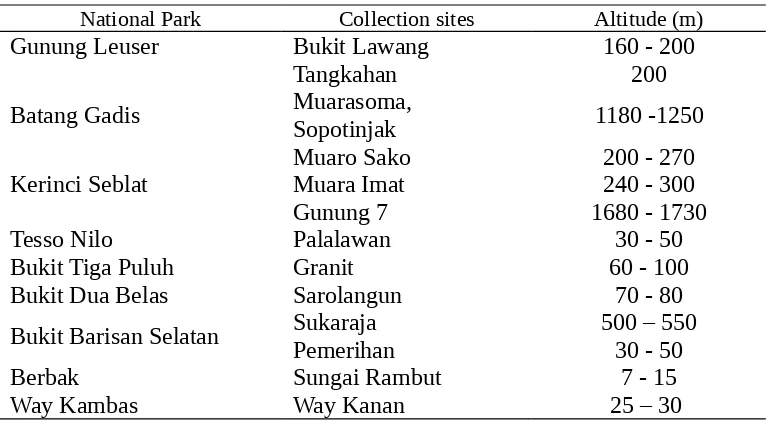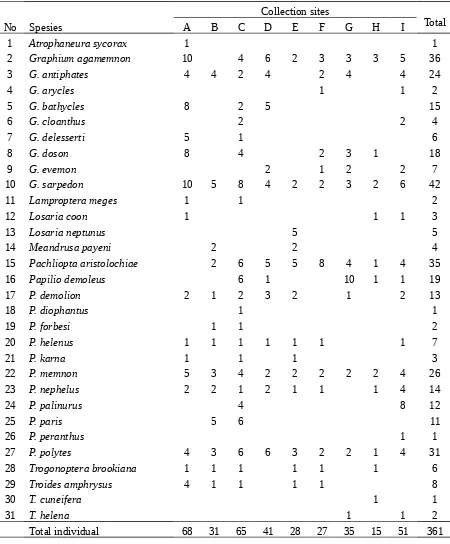Survey of swallowtail butterflies (Lepidoptera: Papilionidae)
at Several National Parks of Sumatra
Dahelmi, Siti Salmah and Henny Herwina
Department of Biology, Faculty of Science, Andalas University, Padang 25163 Indonesia
Abstract
The Papilionidae or swallowtail butterflies are generally recorded as the most spectacular family of Lepidoptera. The purpose of this study is provide taxonomic biodiversity (number of species) of swallowtail butterflies and their host plants at several National Parks of Sumatra. Surveys of swallowtail butterflies are conducted using a‘ Pollard walk’ method. Butterflies were sampled by using hand net. A total of 361 swallowtail butterflies representing 31 species in 10 genera were recorded during the study period. Three species such as Papilio diopanthus, P. forbesi dan P. paris are restricted at high altitude. Nine species of host plants and twelve species of plants as nectar sources for adults were recorded along transect routes.
Key words: Butterflies, Papilionidae, host plants, National Park, Sumatra
Introduction
Butterfly communities in Indonesia are diverse with many endemic species (e.g. 44% in the Papilionidae), most or all of which are dependent to some extent upon closed forest (Collins and Morris, 1985). Among many tropical countries with high biodiversity, Indonesia is also known as the country with both the richest fauna (121 species) and the highest species endemism (53 species) of swallowtail butterflies in the world (Collins and Smith, 1995), Sumatra contains 47 species (Holloway et al., 2001).
butterflies, is conspicuous due to their large body size, which makes field survey easy. In addition, the swallowtails had the highest diversity in the tropics and many of them are listed as endangered by the IUCN Red List in Indonesia (Collins and Smith, 1995). Therefore, swallowtails are the best material for the study of ecology and conservation in Indonesia. Butterfly population and assemblage has not been well studied in Sumatra (Salmah et al., 1997; Dahelmi, 2002), despite the fact that Indonesia has huge butterfly diversity and that such information is fundamental for understanding the characteristics of the local butterfly assemblages. Species of Papilionidae are considered easy to study; they are strongly attracted to flower patches or wet sand, are of large size, and are easy to mark without causing trauma. The aim of this study is to provide taxonomic biodiversity (number of species), through field collections of swallowtail butterflies occurring at National Parks of Sumatra.
Material and Methods
(i) Study areas
This study was carried out at nine National Parks of Sumatra (Figure 1). The principal areas visited are forest interior, urban habitat, and forest gaps. Locations of each site visited are presented in Table 1.
(ii) Sampling of adult butterflies
Table 1. Study areas and collection sites of butterfly at National Parks of Sumatra
Bukit Tiga Puluh Granit 60 - 100
Bukit Dua Belas Sarolangun 70 - 80
Bukit Barisan Selatan SukarajaPemerihan 500 – 55030 - 50
Berbak Sungai Rambut 7 - 15
Way Kambas Way Kanan 25 – 30
and only during periods of full sunlight. Collections are conducted 4-7 ten days for each National Park that depend on weather condition.
(ii) Observation of host plants and nectar plants
The distribution of two potential resources for adults, that is, host plants for oviposition sites and flowering plants as nectar sources are examined. Along of the route of butterfly collections, host plants are observed and collected within the areas 5 m both side of the route. The distribution of nectar plants are examined along the routes during butterfly survey
Results
and P. memnon (7.2%). Kerinci Seblat, Way Kambas and Gunung Leuser National Park
Table 2. Species number of swallowtail butterflies recorded at nine National Parks of Sumatra
No Spesies
28 Trogonoptera brookiana 1 1 1 1 1 1 6
29 Troides amphrysus 4 1 1 1 1 8
30 T. cuneifera 1 1
31 T. helena 1 1 2
Note: A. Taman Nasional (TN) Gunung Leuser, B. TN Batang Gadis, C. TN Kerinci Seblat, D. TN Tesso Nilo, E. TN Bukit Tigapuluh, F. TN Bukit Duabelas, G. TN Berbak, H. TN Bukit Barisan Selatan, I. TN Way Kambas
had high species richness (22, 17 and 17 species, respectively), while Berbak and Bukit Barisan Selatan National Park had only 11 species.
When we compile the number of swallowtail butterflies found in this study and the previous research, in total 36 species of Papilionidae were noted. Nearly 76 % of them were representatives of Sumatra region. However, the number of swallowtail butterflies species recorded \ accounts for only 29.7% of all Indonesian swallowtail butterflies.
Three spesies such as Atrophaneura sycorax, Papilio diophantus, P. peranthus and Troides cuneifera were collected only 1 individual (Table 2). Those species are not recorded in the previous research. Among the recorded butterflies, 28 species were occurred only in low to medium altitude areas (0-1000 m above sea level), and three (Papilio diopanthus, P. forbesi dan P. paris) preferred only high elevation areas (>1000 m).
Table 3. Host plants species recorded for swallowtail butterflies at nine National Parks of Sumatra.
No. Family Species Host plant for 1 Rutaceae Citrus aurantifolia Papilio memnon, P. polytes
2 Rutaceae Citrus amblycarpa P. polytes
3 Rutaceae Citrus sinensis P. polytes
4 Rutaceae Evodia malayana P. demolion, P. karna
5 Rutaceae Clausena excavata P. polytes
6 Lauraceae Cinnamomum burmanni Graphium sarpedon
7 Annonaceae Annona muricata G. agamemnon
8 Annonaceae Polyalthia longifolia G. doson
9 Aristolochiaceae Apama corymbosa Pachliopta aristolochiae
Hibiscus rosa sinensis., Impatiens balsamina., Ixora javanica, Lantana camara, Leea indica, Jathropa sp. and Stachytarpheta indica.
Discussion
The recent findings on the species richness of swallowtail indicated that the number of species recorded in all National Parks was higher than that of the previous study. In the previous study, 27 species of Papilionidae were distributed in Kerinci Seblat National Park (Salmah et al., 1999, 2002). Three species were missed in this study compared to the last recording. They include Graphium ramaceus, Papilio iswara, P. iswaroides. One of them, P. iswaroides was known as species that was distributed at a higher elevation. The butterfly diversity and species richness in the low elevation habitats were higher than in the high elevation habitats (Vu and Decheng, 2003).
In addition, seven species of swallowtails (all males) visited a moist ground for puddling were noticed. This behavior is particularly prevalent in the tropics, although it also occurs in the temperate zone. Puddling behavior is usually predominantly shown by males (Arms et al., 1974; Adler, 1982; Adler and Pearson, 1982; Beck et al., 1999). Some adult butterflies undoubtedly imbibed nectar from flowers at the tops of tall forest
trees. However, as a rule, most butterflies occur within areas of low secondary
vegetation (Parsons, 1999). Greater numbers of butterfly species were associated with
greater numbers of floral species and larval food plants (Croxton et al., 2005). The
occurrence of several butterfly species in a particular habitat type could be explained by
the abundance of their specific host plants (Lomov, 2006). Many species are very
mobile and the counts may largely reflect the attraction of the adult butterflies to
flowering plants. Many butterflies are very specialized regarding larval host plants and
adult nectar sources and therefore sensitive to changes that affect those plants (Nelson,
clustering of flowers, and the tongue length, body mass and wing loading of butterflies
(Corbet, 2000).
Acknowledgements
I wish to thank Mr. Irwan, Asril, Edin WP, and Arif Anthonius Purnama for observing butterflies. This study was supported partly by Department of National Education, Republic of Indonesia, and Nagao Natural Environment Foundation (NEF) Japan.
References
Adler, P. 1982. Soil- and puddle-visiting habits of moths. Journal of Lepidopterist Society 36:161-173.
Adler, P. H and D. L. Pearson. 1982. Why do male butterflies visit mud puddles? Canadian Journal of Zoology 60: 322-325.
Arms, K., P. Feeny and R. C. Lederhouse. 1974. Sodium stimulus for puddling behavior by tiger swallowtail butterflies. Science 185:372-374
Beck, J., E. Muhlenberg and K. Fiedler. 1999. Mud-puddling behavior in tropical butterfliies: in search of proteins or minerals? Oecologia 119:140-148
Collins, N. M and M. G. Morris. 1985. Threatened swallowtail butterflies of the world. The IUCN Red Data Book. Cambridge. U.K. IUCN.
Collins, N. M and H. M. Smith. 1995. Threats and priorities in conserving swallowtails. In Scriber, J. M.., Y. Tsubaki and R. C. Lederhouse (eds.). Swallowtail Butterflies: Their Ecology and Evolutionary Biology. 345-357. Scientific Publishers, Gainesville.
Corbet, S.A. 2000. Butterfly nectaring flowers: butterfly morphology and flower form. Entomologia Experimentalis et Applicata 96(3).
Croxton, P. J., J. P. Hann., J. N. Greatorex-Davies and T.H. Sparks. 2005. Linear hotspots?. The floral and butterfly diversity of green lanes. Biological Conservation 121: 579-584.
Hamer, K. C., J. K. Hill., S. Benedick., N. Mustaffa., T. N. Sherratt., M. Maryati and V. K. Chey. 2003. Ecology of butterflies in natural and selective logged foorests of northern Borneo: the importance of habitat heterogeneity. Journal of Applied Ecology. 40: 150-162.
Hill, J.K., K.C. Hamer., M.M. Dowood. and J. Tangah. 2001. Ecology of Tropical Butterflies in Rainforest Gaps. Oecologia 128. 294-302.
Holloway, J. D., G. Kibby and D. Peggie. 2001. The families of Malesian moths and butterflies. Brill. Leiden. Boston. Koln.
Lomov, B., D. A. Keith., D. R. Britton and D. F. Hochuli. 2006. Are butterflies and moths useful indicators for restoration monitoring? A pilot study in Sidney’s Cumberland plain woodland. Ecological Management & Restoration 7: 204-210.
Nelson, S. M. 2007. Butterflies (Papilionoidea and Hesperioidea) as potential ecological indicators of riparian quality in the semi arid western United States. Ecological Project 3. Field Biology and Training Project. Japan International Cooperation Agency (JICA), Andalas University: 261-270.
Vu, V. L and Y. Decheng. 2003. The differences of butterfly (Lepidoptera, Papilionidae) communities in habitats with various degrees of disturbance and altitude in tropical forest of Vietnam. Biodiversity and Conservation 12: 1099-1111.
Weiss M.R (1995) Floral Colour change: a widespread functional convergence.
Survey of swallowtail butterflies (Lepidoptera: Papilionidae)
at Several National Parks of Sumatra
Running title: Swallowtail butterflies, National Park, Sumatra
Key words: Butterflies, Papilionidae, host plants, National Park, Sumatra
Dahelmi * , Siti Salmah and Henny Herwina
Department of Biology, Faculty of Mathematics and Natural Sciences, Andalas University, Padang 25163, West Sumatra, Indonesia
E-mail: [email protected]
DRATT ARTIKEL ILMIAH
Survey of swallowtail butterflies (Lepidoptera: Papilionidae)
at Several National Parks of Sumatra
Oleh:


